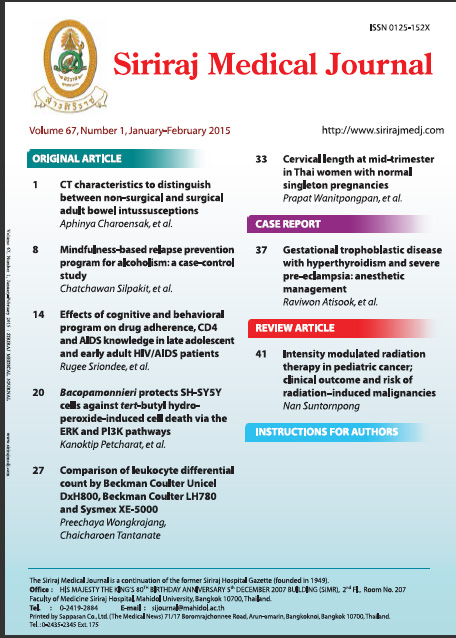CT Characteristics to Distinguish Between Non-Surgical and Surgical Adult Bowel Intussusceptions
Abstract
Objective: To distinguish between non-surgical and surgical adult bowel intussusceptions by using CT characteristics.
Methods: By searching from CT reports between January 2005 to December 2011, there were 76 patients with 82 lesions of adult bowel intussusceptions. CT scans were independently reviewed by two radiologists who were aware that all patients had an intussusception, but not given other clinical and pathological information. Accuracy of each CT characteristic to distinguish between non-surgical and surgical intussusception were calculated.
Results: There were 43 enteroenteric lesions (52.4%) and 39 colonic involving lesions (47.6%). Surgery was performed in 38 lesions (46.3%) and the remaining 44 lesions (53.7%) did not undergo surgery. Five of 43 (11.6%) enteroenteric and 33 of 39 (84.6%) colonic involving intussusceptions received surgery. Lead points were identified in all of the surgical intussusceptions. The mean sensitivity, specificity, positive predictive value, and negative predictive value to diagnose surgical enteroenteric intussusceptions using diameter thickness of > 4 cm, length> 4 cm, proximal bowel diameter > 3 cm, interposed fat thickness > 0.5 cm, and lead points were (100%, 92.1%, 62.5%, 100%); (100%, 47.4%, 20%, 100%); (40%, 94.7%, 50%, 92.3%); (80%, 73.7%, 28.6%, 96.6%) and (100%, 76.3%, 35.7%, 100%), respectively.
Conclusion: The majority of colonic involving intussusceptions undergo surgery. No CT feature is useful to diagnose surgical colonic involving intussusceptions. In contrast, most enteroenteric intussusceptions did not require surgery. Using diameter thickness > 4 cm, could be helpful to diagnose surgical enteroenteric lesions.
Keywords: Intussusception, bowel, gastrointestinal tract, adult, CT
Downloads
Published
How to Cite
Issue
Section
License
Authors who publish with this journal agree to the following conditions:
Copyright Transfer
In submitting a manuscript, the authors acknowledge that the work will become the copyrighted property of Siriraj Medical Journal upon publication.
License
Articles are licensed under a Creative Commons Attribution-NonCommercial-NoDerivatives 4.0 International License (CC BY-NC-ND 4.0). This license allows for the sharing of the work for non-commercial purposes with proper attribution to the authors and the journal. However, it does not permit modifications or the creation of derivative works.
Sharing and Access
Authors are encouraged to share their article on their personal or institutional websites and through other non-commercial platforms. Doing so can increase readership and citations.











